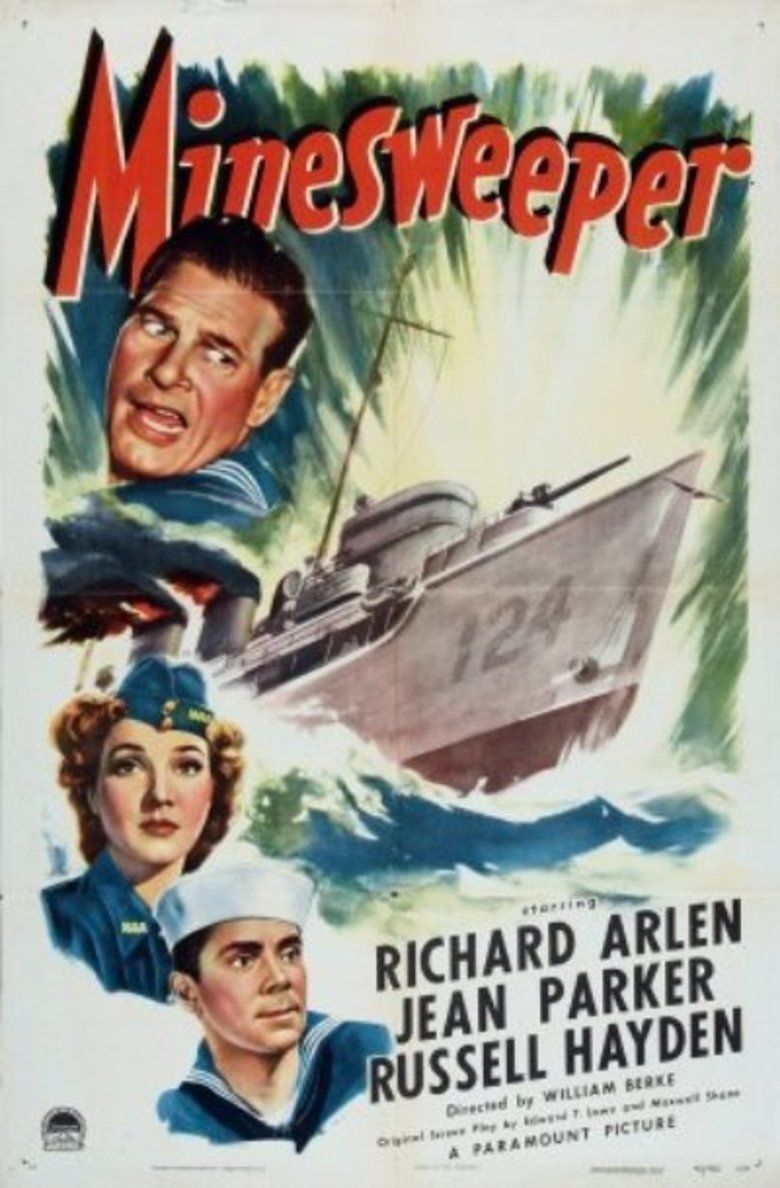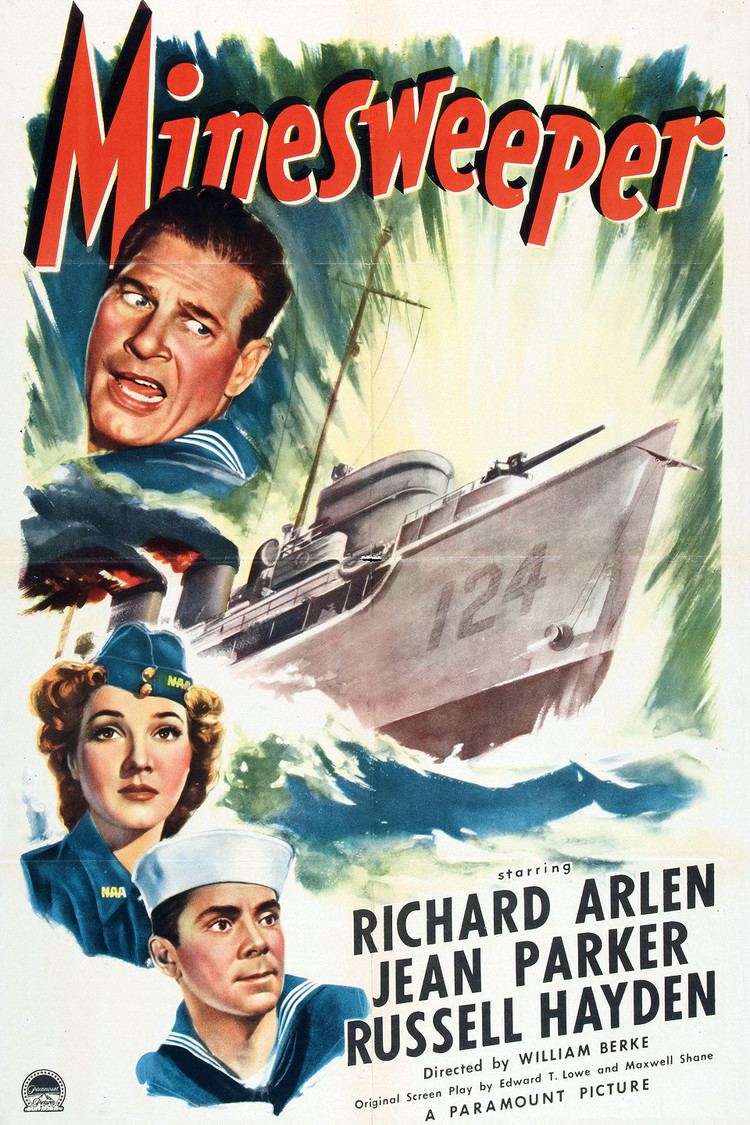Minesweeper (film)
5.4 /10 1 Votes5.4
Duration Country United States | 5.4/10 IMDb Genre Action, Adventure, Comedy Language English | |||||||||||||||||||||||||||||||||
 | ||||||||||||||||||||||||||||||||||
Release date 1943 (1943) Cast (Richard Houston), (Mary Smith), Guinn 'Big Boy' Williams (CPO Ichabod Ferdinand 'Fixit' Smith), (Mom Smith), (Commander Lane), (Lt. Ralph Gilpin)Similar movies Related William Berke movies Tagline DANGER AFLOAT! ABOVE, BELOW AND ACROSS THE SEAS...WITH THE HEROIC MEN OF THE COAST GUARD! | ||||||||||||||||||||||||||||||||||
Minesweeper is a 1943 American film directed by William A. Berke, and stars Richard Arlen, Jean Parker and Russell Hayden. The film is a fictional account of a former navy deserter who returns to duty after the attack on Pearl Harbor, under an assumed name as a sailor aboard a minesweeper in World War II.
Contents

Plot
Lt. Richard Houston (Richard Arlen) is an officer in the U.S. Navy who deserted during peacetime service to escape gambling debts, and took up life as a hobo. The Japanese attack on Pearl Harbor spurs him to rejoin the Navy under the assumed name of Jim "Tennessee" Smith. Houston is assigned to serve aboard a minesweeper, where he carries out numerous successful efforts to defuse mines in the San Diego harbor while struggling to keep his identity secret.
Complicating matters, Houston gets involved in a love triangle, competing with Seaman Elliot Nash (Russell Hayden) for the affections of Mary Smith (Jean Parker), niece of Chief Petty Officer "Fixit" Smith (Guinn "Big Boy" Williams), who has taken a liking to Houston. Later, while gambling, Houston overstays his shore leave and Smith, having taken over his position, is killed by a mine.
Confessing to Mary that he was out gambling to get the money to buy an engagement ring, Houston is crestfallen that by being AWOL, he was responsible for the death of his friend. Houston nearly deserts again, but instead returns to his base to take on one last mission. Reporting back to duty and finding that his immediate superior, Lt. Ralph Gilpin (Frank Fenton), has discovered his true identity. Nonetheless, even as a "prisoner-at-large", Houston volunteers to help clear the shipping lanes of mines to ensure a troop ship can safely leave the harbor to join a convoy off to the Pacific.
When Houston and Nash dive in San Diego harbor to find a Japanese mine, the two divers see that the mine reacts to the sound of an aircraft overhead, beginning to rise from its tethered location as the sound waves reach it. Nash relays the information to Lt. Gilpin on the diving launch, but Houston cuts Nash's oxygen line, forcing the crew on the diving launch to pull him up to safety. Operating on his own, Houston attempts to open the control panel when the mine explodes, killing him. On board the diving launch, Nash tells the crew that Houston was a true hero.
Giplin realizes that he can counter the threat of the mines by flying aircraft low over the water where they can be blown up after they rise to the surface. Looking at the cable he received about the deserter, he tears it up and drops it overboard.
A Consolidated PBY Catalina flying boat flying at low level triggers the release of the acoustically sensitive mines in San Diego harbor, allowing the minesweepers to blow up each mine. As the operation finishes, the Secretary of the Navy sends a message indicating that the Navy and Marine Corps Medal has been posthumously bestowed on Gunner's Mate First Class James Smith, United States Naval Reserve.
Production
Principal photography on Minesweeper took place from May 3 to late May 1943. According to a June 23, 1943 news item in The Hollywood Reporter, underwater scenes were shot off of Santa Catalina Island, California, in June 1943.
In the opening credits, the following acknowledgment appears: "The producers wish to thank the Navy Department for their cooperation in making possible the filming of this picture – and to express especial appreciation to Commander Louis H. Gwinn, U.S.N.R., whose technical aid and advice were of the utmost assistance." According to the information in the Paramount Script Collection at the AMPAS Library, Comm. Gwinn also contributed to the original screenplay.
The minesweeper used during filming was YMS 121.
Reception
Minesweeper was primarily a B film, and although simulated combat scenes were notable, fell short in other aspects. As an example of Hollywood's relentless wartime efforts to portray all the fighting units of the U.S. military in a film, Minesweeper was unique in being the only film depicting the specialized work of minesweping. A May 21, 1943 news item appearing in The Hollywood Reporter, noted that actor Jon Gilbreath who appeared in the film was a Minesweeper Training Officer for the 12th Naval District during World War II.
References
Minesweeper (film) WikipediaMinesweeper (film) IMDbMinesweeper (film) themoviedb.org
